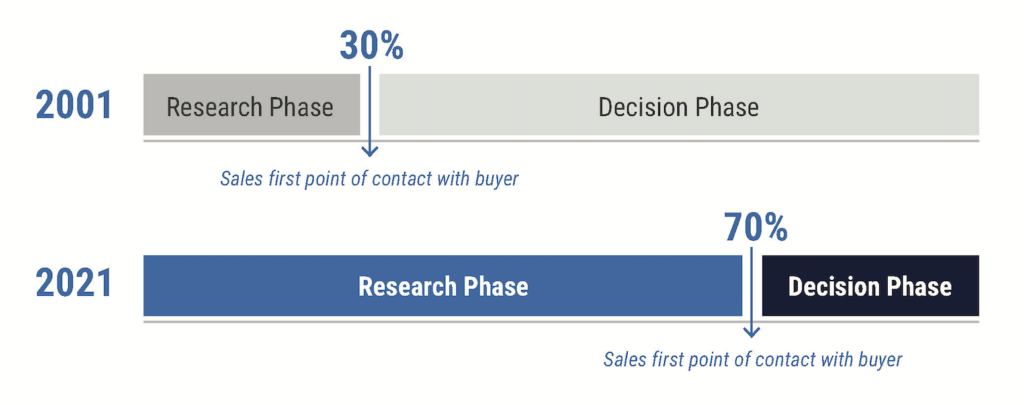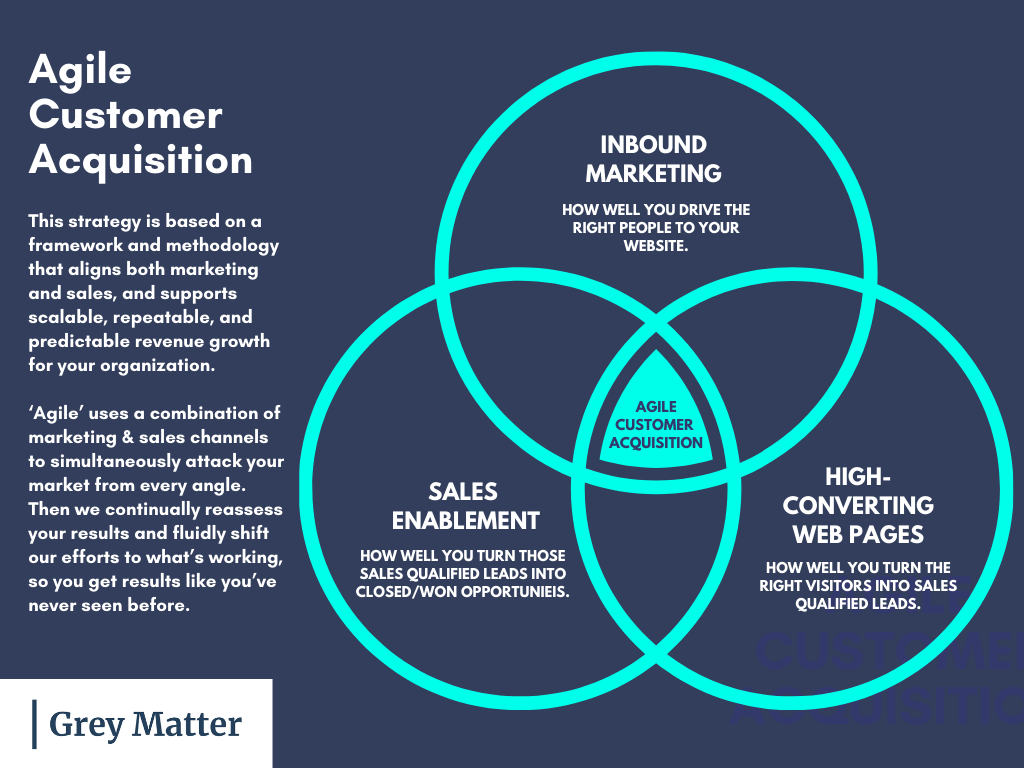Here are 3 things your new marketing partner must deliver for growth success in 2021 and beyond
You’re under pressure to grow. But it’s 2021 – there are more channels and strategies than ever “you’re supposed to be using.” You’re considering new technology that’s supposed to revolutionize your approach, new sales reps to increase activities, spending more on advertising and PR, debating whether to hire internal personnel or an agency…
How do you make the decision as to where to devote your marketing and sales resources in order to grow?
Skate To Where The Puck Will Be, Not Where It Is Now
– Wayne Gretzky
What are the critical differences in how your buyers made purchase decisions back then compared to now?
When it comes to sales growth, you can start by understanding what doesn’t work anymore. New 2021 data may surprise you:
Traditional sales and marketing strategies are now proven outdated – product feature and benefit communication is a losing proposition.
– Harvard Business Review
For instance, while you could rely on adding more sales reps to add revenue in the past, that is not the case today.
To approach 2021 like its 2001 will extend the length of your sales process, waste more of your valuable time, and provide you with less control and visibility into your sales forecasting. Consider the following:

If your approach to sales & marketing doesn’t account for these new realities, your growth forecasts will not be realized.

These are the 3 things your new partner must deliver for growth success in 2021
1. Your partner must bring an integrated process
Making a sale is a process. Yet many companies’ focus is drawn to individual projects and activities. Single activities do not drive revenue, process does.
By today’s standards, if your sales and marketing efforts are not working together with one another, you’re missing out on considerable opportunities.
Making a sale now depends on a considerable digital marketing presence to ensure you can capture prospects on their terms and begin to build trust.
When a potential customer is vetting your company, product or service before they contact you, they need to be able to see anything they want, answer any question they have, online.
If your company is not creating self-serve buying experiences like our Agile Customer Acquisition framework, your sales team will never get the opportunity to meet with new buyers.

2. Your marketing partner must bring an attribution model (ROI) that demonstrates business impact
You’re probably investing in more sales people, technology, advertising, PR… but is any of it working?
40%+ of media spend is wasted on ineffective strategies
– Commerce Signals
Leading indicators are easy to measure and make it “feel” like you’re experiencing success, i.e. email open rates, website visitors, social media shares, etc.
While these are important indicators that you’re making progress, they do not, on their own, spell revenue growth.
Sales numbers are what ultimately matter, though, i.e. did the leads turn into customers?
Multiple leading indicators will add up to lagging indicators, but they need to be analyzed as a process so that you can see which specific activities in your sales and marketing process are producing and which ones are not.
For instance, you may have great digital ad campaigns driving traffic to your site. But if the content on your website is too product-focused, rather than problem-focused, these new prospects will abandon the experience with you.
If you were to just look at the “success” of your ad campaigns, your marketing agency would celebrate all the traffic on your site (leading indicator). Yet, you’d be left wondering, “Why haven’t be actually made any more money from this ‘success?’” (haven’t achieve the lagging indicator)
Using this example, you’d know that in order to maximize your investment in your ad campaigns, you need to evolve the content on your website to drive more conversions.
Your entire sales and marketing process can continuously be improved by analyzing the bottlenecks to prioritize where your resources go next.
This is why sales and marketing need to work closely with one another to share feedback that drives iterative improvements to the process.
Grey Matter reviews all monthly activities across marketing and sales to determine what adjustments need to be made to drive increasing results for every dollar spent.
3. You partner must bring a communication strategy to differentiate your company
Why do 72% of B2B deals end in a no or no decision?
Most sales and marketing focuses on product presentation. But as it turns out, your buyers don’t want to buy your products. They want to solve their problems.
When your buyers choose an alternative option to your offer, they’re saying they’re not confident in your ability to solve their problem.
As we stated earlier, 86% of B2B buyers see no difference amongst suppliers. This means that no amount of sales and marketing is going to convince buyers if they view you as a commodity.
Being able to position your product or service as a solution to their problem is at the core of your sales and marketing approach.
And that’s not as simple as just spouting off the features and benefits.
When a company presents prospects with the features and benefits of their offering first, buyers will instinctively put their guard up because the company has taken no time to establish their own credibility and understanding of the buyer’s situation.
Behavioral scientist BJ Fogg’s research has revealed that no person will change their course of action if the pain of change is greater than maintaining the current state.
Said another way: buyers ain’t buyin’ if you can’t clearly connect their problems to your solutions.
To effectively connect what you offer to solving your buyers’ problems requires a specific presentation of your solution:
- Present the Right Information: Problem-centric content is about your buyer (your focus), whereas product-centric content is about you.
- In the Right Way: Buyers are twice as motivated to change their course of action to avoid a loss as they are to gain something. For example, people are twice as motivated to take action to prevent the loss of $1,000 than they are to take action to gain $1,000.
- In the Right Order: Before buyers can justify the value of what you’re offering them, they need to determine the value of their problem. To do this, you need to quantify the impact of the problem they have if left unchecked.
Simon Sinek’s famous TED Talk sums this concept up with a few examples.
Ready To Talk With Us?
We specialize in making those who partner with us look very smart, whether that’s to the board or your business colleagues. Speaking of that, smart growth shouldn’t cost $35,000/month. An engagement with us is on an ongoing monthly basis and can range from $2,000 to $6,000/month. From strategy to ongoing execution, we’re there every step of the way.









